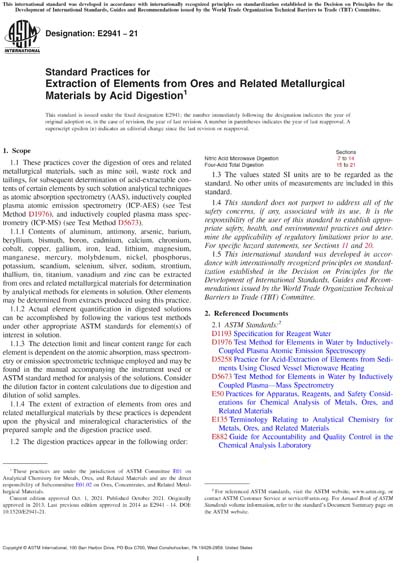Most recent
ASTM E2941-21
Standard Practices for Extraction of Elements from Ores and Related Metallurgical Materials by Acid Digestion
1.1These practices cover the digestion of ores and related metallurgical materials, such as mine soil, waste rock and tailings, for subsequent determination of acid-extractable contents of certain elements by such solution analytical techniques as atomic absorption spectrometry (AAS), inductively coupled plasma atomic emission spectrometry (ICP-AES) (see Test Method D1976), and inductively coupled plasma mass spectrometry (ICP-MS) (see Test Method D5673).
1.1.1Contents of aluminum, antimony, arsenic, barium, beryllium, bismuth, boron, cadmium, calcium, chromium, cobalt, copper, gallium, iron, lead, lithium, magnesium, manganese, mercury, molybdenum, nickel, phosphorus, potassium, scandium, selenium, silver, sodium, strontium, thallium, tin, titanium, vanadium and zinc can be extracted from ores and related metallurgical materials for determination by analytical methods for elements in solution. Other elements may be determined from extracts produced using this practice.
1.1.2Actual element quantification in digested solutions can be accomplished by following the various test methods under other appropriate ASTM standards for element(s) of interest in solution.
1.1.3The detection limit and linear content range for each element is dependent on the atomic absorption, mass spectrometry or emission spectrometric technique employed and may be found in the manual accompanying the instrument used or ASTM standard method for analysis of the solutions. Consider the dilution factor in content calculations due to digestion and dilution of solid samples.
1.1.4The extent of extraction of elements from ores and related metallurgical materials by these practices is dependent upon the physical and mineralogical characteristics of the prepared sample and the digestion practice used.
1.2The digestion practices appear in the following order:
1.3The values stated SI units are to be regarded as the standard. No other units of measurements are included in this standard.
1.4This standard does not purport to address all of the safety concerns, if any, associated with its use. It is the responsibility of the user of this standard to establish appropriate safety, health, and environmental practices and determine the applicability of regulatory limitations prior to use. For specific hazard statements, see Sections 11 and 20.
1.5This international standard was developed in accordance with internationally recognized principles on standardization established in the Decision on Principles for the Development of International Standards, Guides and Recommendations issued by the World Trade Organization Technical Barriers to Trade (TBT) Committee.
ASTM International [astm]

